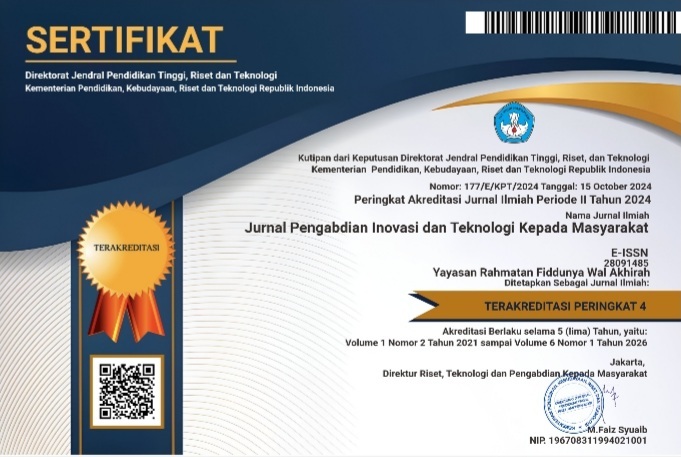Penyuluhan Kesehatan Untuk Pencegahan Sedentary Lifestyle Pada Pelajar SMA
DOI:
https://doi.org/10.58794/jdt.v4i1.891Keywords:
Pelajar, Penyuluhan Kesehatan, Sedentary LifestyleAbstract
Dalam beberapa tahun terakhir, sedentary lifestyle telah menjadi semakin umum di kalangan remaja di Indonesia. Kemajuan teknologi telah berkontribusi pada pengurangan aktivitas fisik, yang menyebabkan berbagai masalah kesehatan seperti obesitas, penyakit mental, dan penyebab kematian lainnya yang sebenarnya dapat dicegah dengan gaya hidup aktif. Studi telah mengidentifikasi berbagai faktor sebagai pemicu sedentary lifestyle di kalangan remaja Indonesia seperti penggunaan media sosial, game virtual, dan layanan streaming yang berlebihan. Menurut data Global School-Based Health Survey (GSHS) tahun 2015 yang diterbitkan oleh Kementerian Kesehatan Indonesia, siswa remaja cenderung mengadopsi pola hidup yang tidak banyak bergerak, sehingga aktivitas fisik berkurang. Sehingga penting untuk mendorong remaja untuk terlibat dalam kegiatan fisik seperti olahraga, rekreasi luar ruangan dan rutinitas olahraga. Untuk memerangi epidemi yang berkembang ini di Indonesia dan di seluruh dunia, sekolah harus secara aktif mempromosikan pendidikan jasmani untuk mendorong kaum muda mengadopsi gaya hidup aktif dan kebiasaan sehat. Kegiatan pengabdian Masyarakat ini bertujuan untuk meningkatkan pengetahuan pelajar SMA mengenai sedentary lifestyle. Kegiatan ini dilakukan di salah satu SMA di Pekanbaru yaitu MAN 1 Pekanbaru. Dari kegiatan pengabdian Masyarakat ini diharapkan pelajar SMA dapat mengenali dan mencegah sedentary lifestyle dalam kesehariannya.
References
C. Howitt et al., “A cross-sectional study of physical activity and sedentary behaviours in a Caribbean population: combining objective and
questionnaire data to guide future interventions,” BMC Public Health, vol. 16, no. 1, p. 1036, 2016, doi: 10.1186/s12889-016-3689-2.
F. D. Andriyani, S. J. H. Biddle, N. I. Arovah, and K. De Cocker, “Physical Activity and Sedentary Behavior Research in Indonesian Youth: A
Scoping Review,” Int J Environ Res Public Health, vol. 17, no. 20, p. 7665, Oct. 2020, doi: 10.3390/ijerph17207665.
M. Manohar, S. K. Uma, and J. Rajendran, “Sedentary behaviour and their association with academic performance among high school students
in South Tamil Nadu,” Int J Community Med Public Health, vol. 6, no. 11, p. 4929, Oct. 2019, doi: 10.18203/2394-6040.ijcmph20195082.
P. Joshi, K. Cole, and M. Overton, “Trends in sedentary behaviors among high school students: Analysis of television and other screen-time
activities,” Journal of Physical Education and Sport, vol. 16, no. 4, pp. 1142–1145, Dec. 2016, doi: 10.7752/jpes.2016.04183.
L. P. Gula, “The Emerging Sedentary Lifestyle of The 21st Century Junior High School Students,” SSRN Electronic Journal, 2022,
doi: 10.2139/ssrn.4306993.
C. H. Wang and N. Peiper, “Association Between Physical Activity and Sedentary Behavior With Depressive Symptoms Among US High
School Students, 2019,” Prev Chronic Dis, vol. 19, p. 220003, Nov. 2022, doi: 10.5888/pcd19.220003.
N. Alfionita, L. Sulistyorini, and E. A. Septiyono, “Hubungan Sedentary Lifestyle dengan Status Gizi Remaja pada Masa Pandemi Covid-19 di
SMPN 14 Jember,” Pustaka Kesehatan, vol. 11, no. 2, p. 92, May 2023, doi: 10.19184/pk.v11i2.37128.
O. Y. Mohammed, E. Tesfahun, and A. Mohammed, “Magnitude of sedentary behavior and associated factors among secondary school adolescents in Debre Berhan town, Ethiopia,” BMC Public Health, vol. 20, no. 1, p. 86, Dec. 2020, doi: 10.1186/s12889-020-8187-x.
S. Paroi, M. A. Hasanat, and B. K. Roy, “Study on the sedentary lifestyle of adolescents in Khulna city,” Mediscope, vol. 9, no. 2, pp. 68–74, Oct. 2022, doi: 10.3329/mediscope.v9i2.61707.
S. N. Putri, B. Santoso, and B. Budiono, “Sedentary Lifestyle and Overweight in Relation to the Risk of Polycystic Ovary Syndrome in Senior High School Students in Surabaya,” JUXTA: Jurnal Ilmiah Mahasiswa Kedokteran Universitas Airlangga, vol. 13, no. 2, pp. 57–61, Aug. 2022, doi: 10.20473/juxta.V13I22022.57-61.
Downloads
Published
Issue
Section
License
Copyright (c) 2024 JDISTIRA - Jurnal Pengabdian Inovasi dan Teknologi Kepada Masyarakat

This work is licensed under a Creative Commons Attribution-ShareAlike 4.0 International License.
JDISTIRA provides open access to anyone, ensuring that the information and findings in the article are useful to everyone. This journal article's entire contents can be accessed and downloaded for free. In accordance with the Creative Commons Attribution-ShareAlike 4.0 International License.

JDISTIRA is licensed under a Creative Commons Attribution-ShareAlike 4.0











